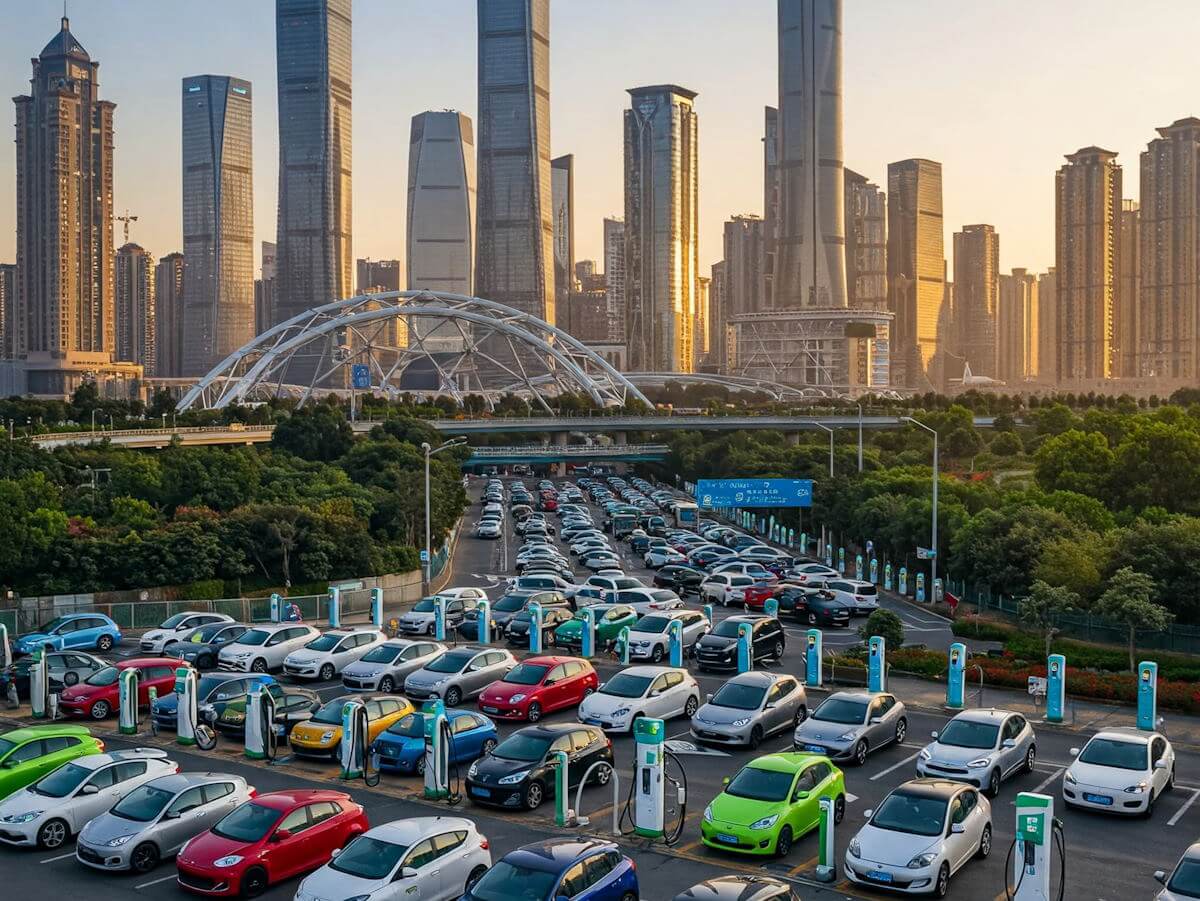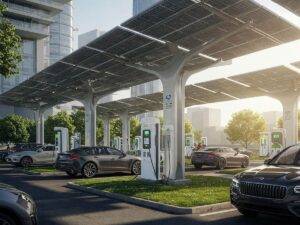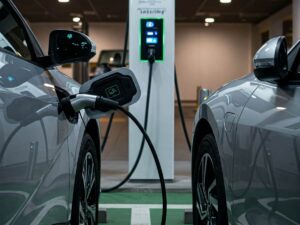In recent years, China has emerged as a global leader in the electric vehicle (EV) market, showcasing significant growth that reflects the country’s commitment to sustainable transportation solutions. With a population exceeding 1.4 billion people, the demand for electric vehicles in China has surged, driven by both governmental support and increasing consumer awareness regarding environmental issues. By 2023, statistics indicate that over 6 million electric vehicles were sold in China alone, accounting for more than half of the global market share. This rapid expansion illustrates not only the local consumer’s shift towards cleaner alternatives but also China’s pivotal role in the worldwide transition to sustainable mobility.
The timeline of EV adoption in China can be traced back to the early 2000s, when the first policies aimed at promoting electric mobility were introduced. As part of an effort to combat severe air pollution and reduce dependency on oil imports, the Chinese government has implemented numerous incentives for EV production and consumption. These include extensive subsidies for electric vehicle manufacturers, investment in charging infrastructure, and ambitious targets for EV sales as part of the broader “Made in China 2025” initiative. Such policies have fostered a conducive environment for automotive innovation and have led to the rise of domestic EV manufacturers such as NIO, BYD, and Xpeng Motors.
The implications of China’s dominance in the EV sector extend far beyond its borders. As one of the largest markets for electric vehicles, China’s policies and production capabilities may set the standard for other nations aiming to enhance their own EV infrastructure. Moreover, the aggressive strategy for electrification can also influence global supply chains, technology transfer, and competition among automobile manufacturers worldwide. The rapid growth of China’s EV market marks a defining moment in the automotive industry, steering the world towards a more sustainable transportation future.
Government Policies and Incentives
The rapid advancement of the electric vehicle (EV) sector in China can largely be attributed to a combination of well-structured government policies and financial incentives. These measures have fostered a favorable environment for both manufacturers and consumers, subsequently positioning China as a leader in the global EV market.
One of the most significant initiatives has been the provision of subsidies for consumers who purchase electric vehicles. These subsidies can substantially lower the up-front costs associated with buying an EV, making them more accessible to a broader segment of the population. The Chinese government has also introduced incentives for manufacturers, which encourage the production of EVs by providing financial assistance and grants for research and development aimed at enhancing battery technology and vehicle performance.
Additionally, investments in charging infrastructure have been a critical focus. The Chinese government has allocated substantial resources to develop an extensive network of charging stations across urban and rural areas. This strategic expansion not only alleviates range anxiety among potential EV buyers but also promotes the adoption of electric vehicles by ensuring convenient and widespread access to charging facilities.
Moreover, stringent regulations aimed at reducing emissions have played a pivotal role in accelerating the transition towards sustainable transportation. The implementation of targets for carbon emissions is prompting manufacturers to innovate and produce cleaner alternatives, further invigorating the electric vehicle market. The push for greener practices is not only confined to automobiles but extends to public transportation and commercial fleets, boosting overall acceptance and reliance on electric mobility solutions.
Through these comprehensive policies and incentives, the Chinese government has crafted an ecosystem conducive to the growth of the EV market, creating a model that could inspire similar initiatives by other countries. Enhanced collaboration between government bodies and private industry will likely continue to shape the future of electric transportation in China and beyond.
Major Players in China’s EV Industry
China has emerged as a global leader in the electric vehicle (EV) sector, with several prominent manufacturers shaping the landscape. Among these, BYD, NIO, and Xpeng stand out as key players, each employing distinct strategies and innovations to capture a significant share of the market.
BYD, known for its diverse range of electric vehicles including buses, trucks, and passenger cars, has established itself as a dominant force in China’s EV market. The company’s vertical integration strategy allows it to control key components, from batteries to vehicles, ensuring quality and cost-effectiveness. In recent years, BYD has focused on expanding its international presence, with plans to enter markets in Europe, Latin America, and beyond, further solidifying its position against both domestic and international competitors.
NIO, often referred to as the “Tesla of China,” has gained recognition for its premium electric SUVs and innovative battery-swapping technology. This feature allows NIO users to exchange depleted batteries for fully charged ones in a time-efficient manner, addressing one of the significant concerns regarding EV usage—range anxiety. Additionally, NIO has invested heavily in research and development, enabling it to introduce cutting-edge technologies and advanced navigational systems, enhancing the user experience and maintaining a competitive edge.
Xpeng has carved a niche in the smart EV segment with a strong focus on technology integration and autonomous driving capabilities. The company’s vehicles are equipped with advanced driver-assistance systems (ADAS) that appeal to tech-savvy consumers. Its strategy involves leveraging software updates to enhance vehicle performance and introduce new features post-purchase, which further attracts customers looking for a modern driving experience. Xpeng’s partnerships with technology firms also bolster its competitive positioning against established international automotive brands.
These major players in China’s EV industry exemplify the dynamic and rapidly evolving nature of the market. Their respective strategies, ranging from vertical integration to technological innovation, contribute to China’s standing as a leader in the global electric vehicle landscape.
Technological Innovations Driving Growth
China’s electric vehicle (EV) market has witnessed remarkable growth, primarily driven by technological innovations that enhance performance, safety, and consumer appeal. Central to this progress is the advancements in battery technology. As the heart of an electric vehicle, battery efficiency directly impacts range, charging time, and overall usability. Chinese manufacturers, such as BYD and CATL, have made significant investments in lithium-ion battery technology, thus improving energy density and reducing costs. This has not only made Chinese EVs more affordable but has also increased their range, thereby addressing one of the primary concerns for consumers.
Another significant aspect contributing to the competitiveness of Chinese EVs is the development of autonomous driving features. Companies like NIO and Xpeng Motors are at the forefront of enhancing user experiences through self-driving capabilities. By integrating artificial intelligence and advanced sensor technologies, these manufacturers are offering innovative solutions that enhance driver safety and convenience. The Chinese government’s supportive policies in promoting autonomous vehicle testing also facilitate rapid advancements in this area, allowing manufacturers to refine their technologies faster than many of their international competitors.
Furthermore, smart connectivity has emerged as a vital feature in the Chinese EV market. Integration of Internet of Things (IoT) technology within vehicles allows for real-time data sharing, enabling functions such as navigation, remote diagnostics, and over-the-air software updates. This connectivity not only enhances user experience but also ensures that vehicles remain updated with the latest technological advancements, promoting long-term consumer engagement. These innovations contribute to making Chinese EVs not only viable alternatives to traditional vehicles but also attractive options for consumers worldwide, thereby positioning China as a leader in the global electric vehicle market.
Impact on Global EV Markets
China’s preeminence in the electric vehicle (EV) market has generated significant reverberations across global automotive dynamics. As one of the largest producers and consumers of electric vehicles, China’s influence extends beyond its borders, shaping trends, standards, and market behaviors in various regions. The burgeoning domestic demand for EVs, paired with government incentives aimed at reducing emissions, has led to China emerging not only as a crucial player but also as a benchmark for international manufacturers.
International automotive companies face both challenges and opportunities due to China’s dominance. On one hand, established firms from Europe and the United States must adapt to the competitive pricing and technological advancements pioneered by Chinese manufacturers. Many of these companies are recognizing the need to innovate rapidly, often by investing massively in research and development to compete in this fast-evolving marketplace. Furthermore, the integration of smart technologies and battery innovations in China’s EVs poses a challenge to global brands, compelling them to rethink their strategies and offerings.
On the flip side, China’s vigorous advancements in EV production also present opportunities for collaboration and partnership. Global manufacturers may seek to leverage China’s well-developed supply chain, which is crucial for battery production and components essential for electric vehicles. By establishing joint ventures or partnerships with Chinese companies, international firms can enhance their competencies and gain access to advanced technologies sourced from the world’s largest EV market.
Consumer preferences are noticeably shifting as well. As Chinese EVs gain traction in quality and public acceptance, consumers around the world may increasingly embrace models from China, influenced by factors such as affordability and innovative features. This transformation may catalyze broader market acceptance for electric vehicles, benefiting not only Chinese manufacturers but potentially accelerating the global transition towards sustainable transportation solutions.
Environmental Considerations
China’s emergence as a leader in the electric vehicle (EV) market has significant environmental implications, particularly in terms of reduced greenhouse gas emissions and improved air quality. By promoting the adoption of electric vehicles, China aims to combat the severe air pollution that plagues many of its urban areas. The shift to EVs is expected to contribute to a reduction in reliance on fossil fuels, thereby lowering carbon emissions associated with traditional internal combustion engine vehicles. As countries around the world grapple with the challenges of climate change, China’s efforts in the EV sector represent a crucial step towards achieving global sustainability goals.
However, while the transition to electric vehicles may present clear advantages, it is essential to consider the environmental challenges associated with battery production and disposal. The mining of lithium, cobalt, and nickel—key components of EV batteries—raises important concerns about environmental degradation and social justice in the regions where these materials are sourced. Furthermore, the processes involved in battery manufacturing can generate considerable pollution. Critics argue that, without proper regulations, the expansion of the EV market may inadvertently lead to more environmental issues, undermining the very benefits that electric vehicles aim to provide.
Battery disposal also poses a significant challenge, as improper handling of used batteries could lead to harmful chemical leaks and ecological damage. To address these issues, it is crucial for China and other EV-producing countries to develop robust recycling programs and invest in research for more sustainable battery technologies. For example, advancements in solid-state batteries and alternative materials could minimize the reliance on scarce resources and improve the overall lifecycle impact of electric vehicles.
In conclusion, while China’s dominance in the EV market has the potential to contribute positively to global environmental outcomes, a comprehensive approach is necessary to mitigate the associated challenges related to battery production and disposal. Balancing the benefits and drawbacks will be key to maximizing the ecological advantages of electric vehicles.
Geopolitical Ramifications
The meteoric rise of China as a dominant player in the electric vehicle (EV) market has far-reaching geopolitical implications that are shaping global dynamics. One of the primary ramifications pertains to trade relations. China, possessing a significant share of the global EV supply chain, is poised to shift traditional trade dependencies. Countries with a vested interest in the EV market are increasingly likely to engage in partnerships or trade relations with China, often at the expense of Western automotive and technology companies. This shift may lead to recalibrated alliances and a reevaluation of existing trade agreements, particularly in the automotive and this correlated sector.
The competition for essential raw materials, such as lithium and cobalt, further underscores the geopolitical stakes surrounding China’s EV dominance. As the global demand for EVs escalates, so does the need for these critical minerals. Countries rich in these resources may find themselves courted by global powers, including China, as they seek to secure access to these materials for their EV production. This rush to control resources could exacerbate tensions and lead to trade conflicts or strategic partnerships that are primarily driven by resource acquisition, with nations aligning themselves along resource availability and bargaining power.
Furthermore, China’s leadership in the EV market influences global energy policies and alignments among nations. As countries transition from fossil fuels to renewable energy, China’s focus on electric vehicles aligns with broader environmental goals, such as reducing carbon emissions and combating climate change. This scenario provides China with a unique positioning in international negotiations regarding climate action and energy sufficiency. By fostering the transition to EVs, China is not only positioning itself as a technological leader but also strategically leveraging its influence to shape the energy policy landscape worldwide.
Challenges Facing the EV Market in China
China’s electric vehicle (EV) market has seen remarkable growth in recent years, positioning the country as a global leader in the sector. However, this rapid expansion comes with several challenges that could hinder sustainable development and threaten its dominance. Among these challenges are fierce competition from international and domestic players, regulatory hurdles, supply chain complexities, and varying consumer adoption rates.
First, competition in the EV sector is intensifying as established automotive giants from countries such as the United States, Germany, and Japan are aggressively entering the market. Additionally, domestic brands are rapidly innovating and enhancing their technologies to maintain and gain market share. The influx of new entrants creates an environment where companies must continuously invest in advancements to differentiate themselves. As competition increases, profit margins may shrink, potentially leading to volatile market conditions.
Regulatory hurdles significantly impact the EV landscape in China, as the government continues to refine policies related to emissions, safety standards, and incentives for manufacturers. While fiscal incentives have initially spurred EV adoption, reliance on subsidies poses a long-term risk. The government’s gradual reduction of financial support may lead to market instability and affect consumer confidence, prompting the need for manufacturers to innovate in order to appeal to price-sensitive buyers.
Supply chain issues present another critical challenge. The global semiconductor shortage has adversely affected production schedules, and the heavy reliance on imported raw materials can lead to disruptions in manufacturing. Moreover, companies must also navigate the complexities of building an efficient charging infrastructure to support consumer adoption, particularly in rural areas.
Consumer adoption rates remain mixed, influenced by factors such as perceived range anxiety, initial costs, and the availability of charging stations. Addressing these concerns is vital for fostering long-term growth. Moving towards a sustainable growth model is essential for the Chinese EV market while balancing the need for innovation, competitive pricing, and viable consumer engagement strategies.
Future Prospects for China’s EV Dominance
The trajectory of China’s electric vehicle (EV) market suggests a robust and dynamic future, poised for significant advancements and unexpected developments. As of 2023, China has firmly established itself as the leading player in the global EV marketplace, and forecasts indicate this dominance is likely to persist through 2030 and into the following decade. A variety of factors contribute to this optimistic outlook, including increasing domestic demand, favorable governmental policies, and the ongoing development of battery and charging technologies.
Market growth projections are particularly encouraging. Analysts anticipate that the demand for electric vehicles in China will continue to surge, fueled by a combination of rising environmental awareness and stringent emissions regulations. By 2030, it is estimated that electric vehicles could comprise over 50% of all new vehicle sales in China. This shift not only represents a profound transformation in consumer preferences but also reflects the increasing commitment of the Chinese government to support sustainable transportation options through subsidies and infrastructure investments.
Technological breakthroughs are another key component of the future landscape of China’s EV market. Innovations in battery technology, including solid-state batteries and advancements in lithium-ion technologies, stand to improve vehicle performance, increase driving range, and reduce costs. Such developments would not only enhance the user experience but also promote heightened adoption rates among consumers. Furthermore, China’s significant investments in research and development are anticipated to yield new solutions to challenges such as energy storage and charging speed, making electric vehicles even more attractive.
However, challenges do exist on the horizon. As global competition intensifies, particularly from the United States and Europe, China’s dominance in the EV sector may face pressure. The evolving geopolitical landscape and shifting trade relationships could impact collaboration and technology exchanges, potentially reshaping the market dynamics. Nevertheless, if China continues to innovate and address these global challenges, its position in the electric vehicle industry is expected to remain unassailable well into the next decade.




